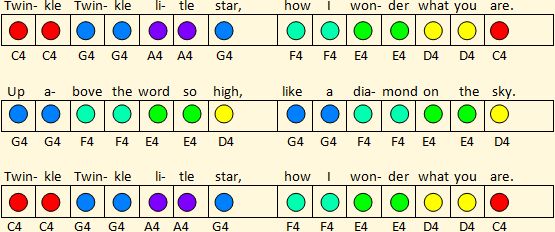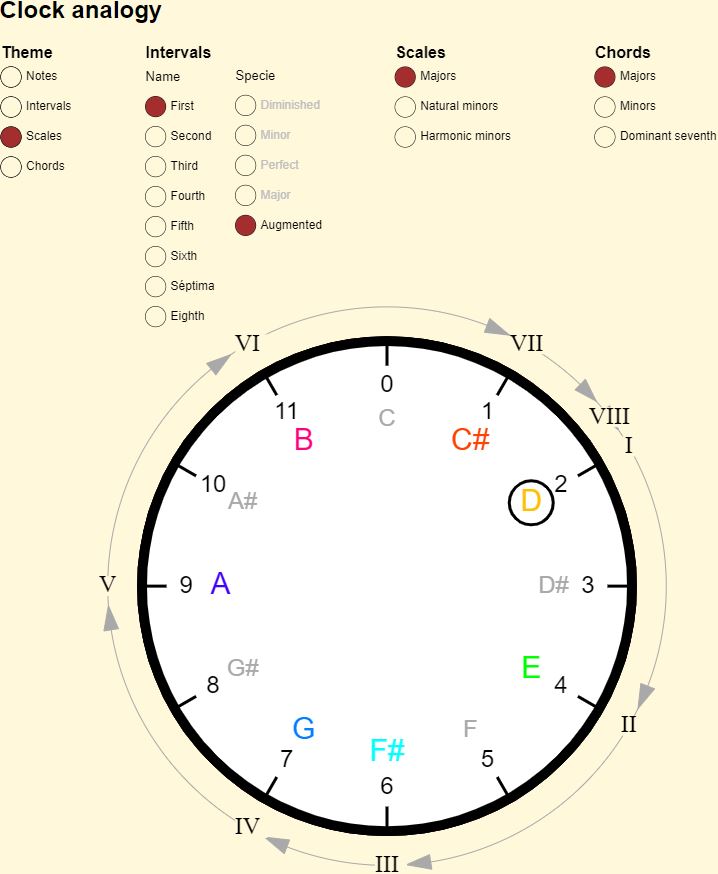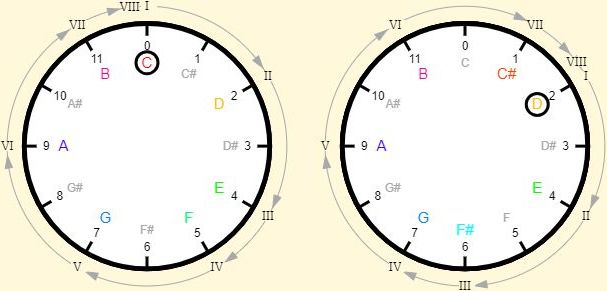
Musical notes
Content
A simple experimentA simple melody
Notes on the staff
The clock analogy
A simple experiment
In the beginning section it was pointed out that to make music it is necessary to select from the infinite set of different sounds a set of notes that lend themselves to this end. Below is a device that will help you reproduce the type of experiments that led different cultures to the selection of musical notes. It consists of two equal and equally tensioned strings; the upper one vibrates at a fixed f0 frequency of 260.74Hz (C4), and the second frequency can be varied by dragging the yellow nut.
Perform the following actions:
- Press the touch button. The two strings produce the same sound (unison).
- Move the yellow nut a little to the right until you get a frequency of about 300 Hz. Press the Touch button again; you will hear an unpleasant sound in which you can discern the frequencies of both strings.In what follows, you will move the nut so that the sounds of both strings have a relationship of harmony.
- Move the yellow nut to a place close to half the length of the strings and adjust its position carefully until a pleasant sound is obtained in which it is difficult to discern between the sounds of both strings.Calculate and write down the ratio of the frequency of the lower string to that of the upper string.If you have done your job carefully you will have obtained a ratio close to 2/1 and a frequency f8va s 521.48Hz(C5) corresponding to the first octave of f0.
- Starting from its position in the middle, move the yellow nut to the left until a frequency of around 400Hz is obtained. Carefully continue moving the cursor to the left and listening to the result until you get a sound in which there is harmony between the sounds of both strings. Calculate and write down the ratio of the frequency f1 of the lower string to that of the upper string, this should be around 3/2 (1.5); if necessary,reset f1 to 1.5 * f0 x 391.11Hz (G4). When studying the intervals we will see that the interval between f0 and f1is called the perfect fith.
The simple previous experiment provides all the information needed to develop a musical scale that begins with C4. Two facts stand out from the results of this experiment:
- Notes whose relationship is a multiple of 2 are equivalent and can be given the same name.In our experiment both C4 and C5 are called "Do", but they belong to different octaves.There will also be other C notes downwards: C3 (130.37Hz), C2 (65.19Hz)... and upwards: C6 (1042.96 Hz),C7 (2085.93Hz)...
- Frequencies whose ratio is 3/2 have a harmonious relationship and together are pleasing to the ear.
To obtain a scale we can proceed as follows:
- Due to the equivalence between octaves we will limit our interest to the search for harmonic notes in the range from C4 to C5.
- We use the 3/2 and 2/3 (fifth), 2/1 and 1/2 (octave) ratios, to add new notes. We start by adding the note of frequency 1.5 * f1 = 586.67Hz transferred to the octave that interests us: f2 = 293.33Hz (D4).We add f3 = 1.5 * f2 = 440Hz (A4). We add 1.5 * f3 = 660.00Hz transferred to octave C4-C5: f4 = 330.00Hz (E4).We have thus obtained the major pentatonic scale for C that we use when developing our simple pentatonic instrument used in the first section. The following figure shows the assignment of the six frequencies obtained to the first six keys:

The notes and their frequencies for the remaining four keys are simply octaves of those corresponding to the second to fifth keys.
The described procedure can be continued to obtain the frequencies f5 = 495.00Hz (B4), f6 = 371.25Hz (F # 4), f7 = 278.44Hz (C # 4), f8 = 417.66Hz (G # 4), f9 = 313.24Hz (D # 4), f10 = 469.86Hz (A # 4), f11 = 352.40Hz (F4), f12 = 528.60Hz. This last value is extremely close to the frequency f8va = 521.48Hz (C5) corresponding to the octave of f0 = 260.74Hz (C4), the ratio between them is 1.0136 / 1, and transferring to the interval from C4 to C5 leads at the frequency of 264.30Hz very close to f0, with which it has the same ratio of 1.0136 / 1. It is possible to demonstrate mathematically that this procedure produces infinite frequencies in the range of one octave without producing the frequency f0 again. Indeed, the frequency of the notes obtained is given by the expression

in which m = 1,2, 3, ... and n & le; m, but this only produces the value f0 for m = n = 0 because for other values the numerator of the fraction will be odd while the denominator will be even, therefore their ratio cannot take the value 1. Since we have already obtained a value quite close to f0, the search for musical notes is terminated.
The order in which the different notes on the octave that goes from C4 to B4 were located is C4, G4, D4, A4, E4, B4, F # 4, C # 4, G # 4, D # 4, A # 4 and F4, the same in which they will appear in a very important theoretical resource such as the circle of fifths, but does not correspond to the order of their respective frequencies; it is convenient to reassign indices to these frequencies:

This table contains all the notes on the chromatic scale that starts in C4 and culminates in C5. The color scheme described on the home page has been used to identify the notes corresponding to the major scale of C over this interval; this is a fundamental scale from the point of view of music theory, so we will study it in detail in the pages dedicated to the study of scales.
Although we limit ourselves to determining musical notes in the octave that goes from C4 to C5, the first result obtained from the experimentation indicates that we can immediately obtain the notes corresponding to other octaves.
The hearing range of humans is approximately 20Hz to 20,000Hz. An extended range piano ranges from A0(27.5Hz) to C8(4.186Hz), an acoustic guitar from E2(82Hz) to F6(1.397Hz). A linear scale is not appropriate to locate such a wide range of frequency values, much more appropriate is to use a logarithmic scale of base 2 since each octave contains exactly the same musical notes. Let's look at the distribution of notes from C4 to C7:

For the purpose of manufacturing string instruments that use frets the choice of the frequencies of the notes according to the system described, in which the frequencies of the notes are obtained by

is not suitable for the manufacture of stringed instruments using frets, since it produces consecutive notes whose frequency ratio is irregular since, according to the table above, it can assume the values 1.068 and 1.053, which complicates its application. An alternative scheme used by most manufacturers, and which we will use for the instruments in these pages, is based on the fact that the notes are repeated by octaves, i.e. by multiples of 2 elevated to n. The notes are calculated using the following expression:

so that the quotient between consecutive notes is the constant value of 2 raised to 1/12 (= 1.059). The new frequency values for the notes of the equally tempered chromatic scale are shown below:

To obtain these frequencies, the frets are placed at a distance

ffrom the bridge of the instrument.
Since the 440Hz frequency is used as the standard reference for the tuning of musical instruments, in the creation of the sets of notes in both tables the frequency of C4 was selected so as to obtain this value for A4.
A simple melody
On the home page we point out that in the simple instrument provided, which does not have all the notes obtained on this page, it was not possible to play many of the known melodies. In the resources page you can access a more complete keyboard, which has the four octaves that go from C2 to C6; with it you can interpret the melody of almost any popular piece known. A simple arrangement of the melody "Twinkle Twinkle Little Star" is as follows:

This is an extremely simple melody with a high degree of organization in time and only three different groups of notes organized in two musical phrases, so you will not find it difficult to learn to play it.
Practice. Use the keyboard provided on the resources page to learn "Twinkle Twinkle Little Star". The keyboard opens in a separate window; you can adjust the size of this window and that of UkuleleMate to arrange them in such a way that you can easily visualize the transcription of the melody during your practice
Notes on the staff
In order to facilitate the study, we have used a very visual notation system; however, it is convnient for you to familiarize yourself with the usual musical notation. It does not require much effort to learn the basics of this notation, but the retribution for this effort is great, as it will allow you to benefit from the extensive literature available in this nomenclature; you will then be able to interpret the great variety of melodies written using this notation. We will introduce it as we need it, and for ease of reference we have included a brief introduction to musical notation.
The clock analogy
An extremely fortunate fact in the choice of twelve notes for the chromatic scale in Western culture is that arithmetic module 12 can be used in the studies of its music. This is facilitated because we are very used to this type of arithmetic, since it is also used in the measurement of the hours of the day. This can be clearly seen in the circular dial clocks: at the beginning of the day the hour hand starts from zero and turns indicating the hours 1, 2, 3, ... until reaching its initial position at noon, the 12 or XII stamped on its cover, the rest of the day marks again 1, 2, 3, ... for hours 13, 14, 15, ...; this corresponds to arithmetic module 12: the residuals of dividing 13, 14, 15, ... by twelve are precisely 1, 2, 3, ... If we are familiar with military time we can determine almost instantaneously that five in the afternoon corresponds to the seventeen hours and that the nineteenth hour corresponds to seven at night. In these pages we will try to take advantage of these facts using what we will call the clock analogy to perform usual tasks in music: determine scales, determine the notes of a chord, determine the chords of a family of chords in any tone, transport melodies, etc. To simplify these tasks, the "Clock analogy" button has been included in the resources page, which allows you to load a page that facilitates the understanding and application of this analogy. To facilitate the use of this resource, the Manual for the use of the clock analogy has been developed.
The following figure shows the result of selecting the D major scale for display on the clock face:

Note that the characters corresponding to the notes on the scale have been enlarged and use the agreed colours for the notes on the home page, the rest of the notes are shown in grey; the degrees corresponding to the notes on the scale are also indicated. Degrees will be studied in the section on scales. If you carried out the previous exercise based on the table corresponding to the major C scale, you were forced to extend the table to adapt it to the D tonality. One advantage of the clock analogy is that it is cyclic, which avoids having to add notes or change their position. If the notes of the scale are not differentiated by colours, all the work consists of indicating their degrees on the periphery of the dial of the clock.

Frequency of sound emitted by a string
The frequency of the sound produced when plucking a string is given by:

where:
- f is the vibration frequency of the string
- L is the length of the string
- T is the tension applied to the string
- μ is the density of the string material
One can verify that the frequency f8 (523.25Hz) corresponding to the octave of f1 (261.63Hz) is obtained by reducing the length of the string by half, and the frequency f2 (392.44Hz) corresponding to the fifth is obtained by reducing the length of the string by two-thirds
.